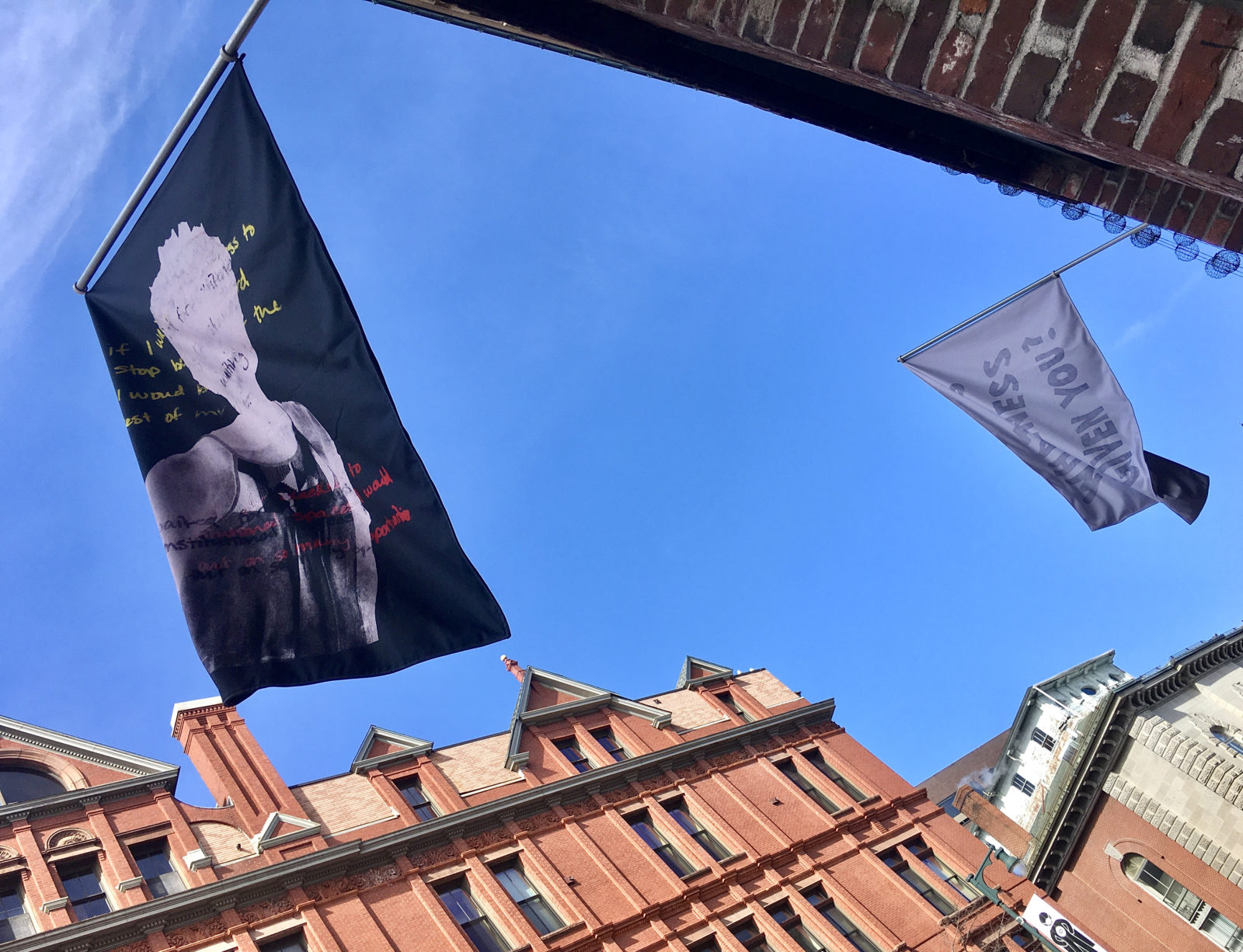Juliette Walker (JW) – Leah Grant and I are both graduate students in the University of Arkansas MFA program. Currently Leah is a 3rd year and I am a 2nd year. We have both been commissioned to create artist flags on SPACE’s facade in downtown Portland, Maine. This conversation explores that work and our experiences in the institutional spaces that we share- me as a white woman and Leah as a Black woman. Our flags both definitely speak to the individual experience for each of us.
Leah Grant (LG) – Yes Juliette, thank you for inviting me to collaborate with you and SPACE and I am really looking forward to it. I think it will be a unique way to view art differently. I have never done anything with flags, but Juliette has been doing a lot with flags for a while which is so cool.
JW – I am definitely excited to see your prints in the form of a flag and just grateful for this conversation and having our work in conversation outside of SPACE.
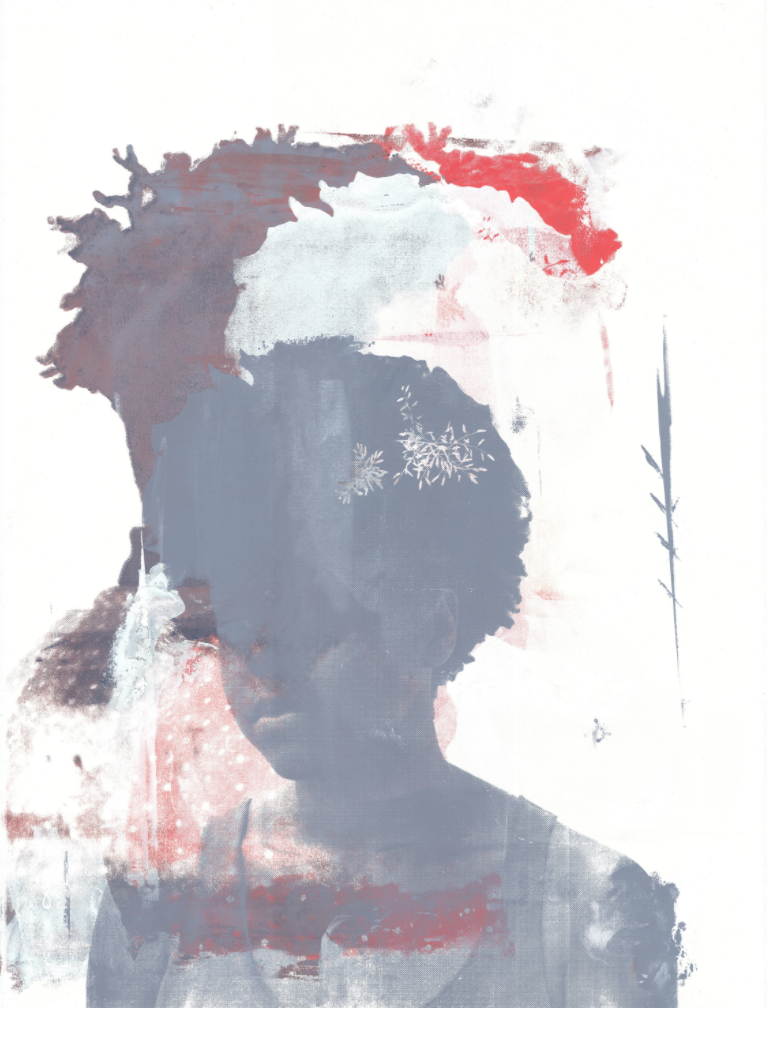
LG – I know you had an installation at Public Storage in the fall and it was really great to see all of your flags hung together. It invited another conversation. The text that was on the flags posed a lot of questions to the public and specifically with the flag you are showing at SPACE now, you question whiteness in a way that keeps whiteness accountable. I was wondering what made you bring awareness to your whiteness in an art institution.
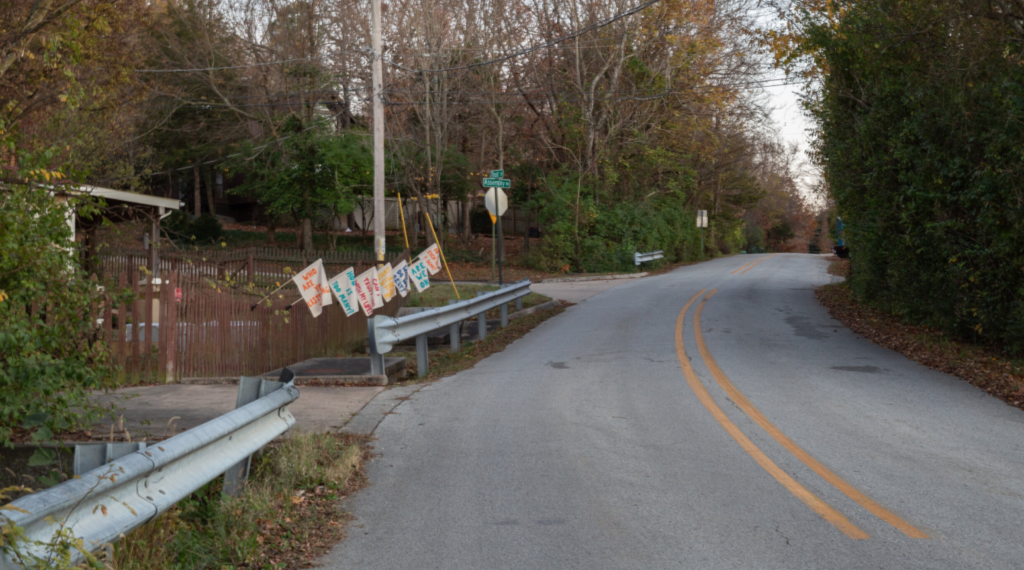
JW – Beginning with the protests of the police murders this summer and all the conversations and protests that have continued since then, I feel like it has really woken me up out of my stupor, of not fully recognizing or acknowledging the enormous privilege that I have as a white artist operating in these institutional spaces. It was a wake up call for me to first of all truly recognize and internalize the position that I am in as a white artist. Throughout my life and career so far it is easy for me to work in institutions because whiteness is centered. These spaces were built for white people like me. If myself and other white artists want our institutions to be democratic, equitable, and fair, then we have to be talking about this and making work about this. We have to start calling out our own whiteness- I have been operating within this system as a white person and benefiting from that. That is what prompted this piece, What has whiteness given you?/ What has whiteness taken from you? It is the first time I have discussed my race overtly at all in my artwork. It is just the beginning of what needs to happen, just scratching the surface.
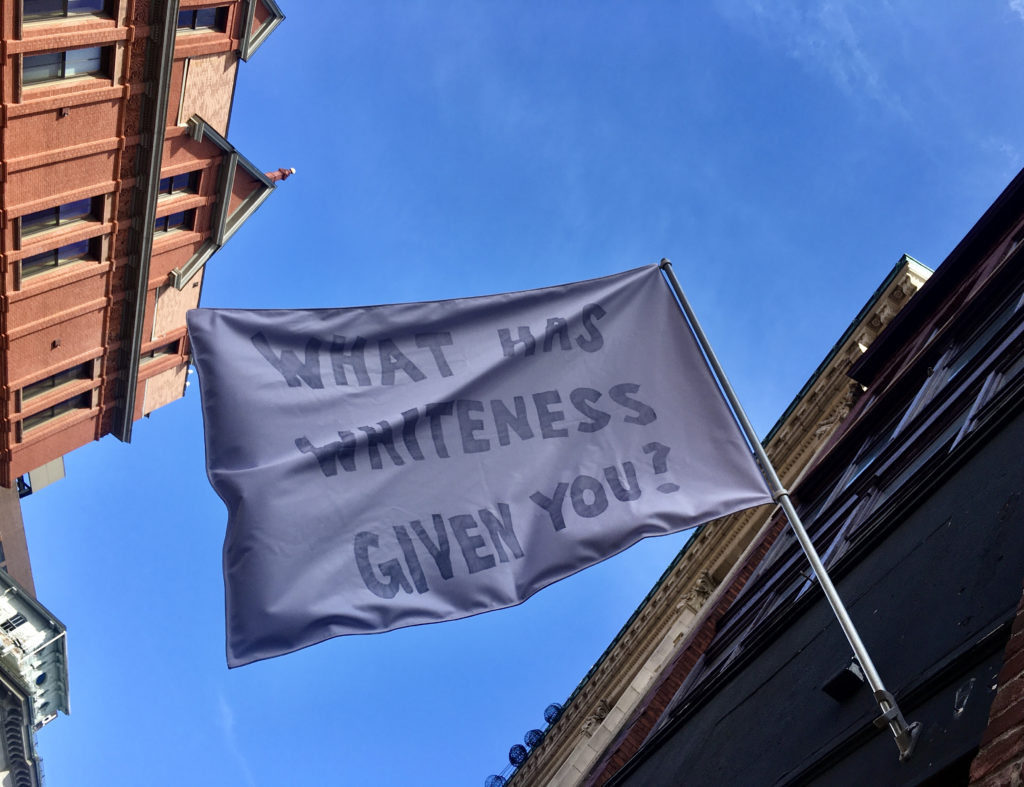
Photo credit: Carolyn Wachnicki
LG – Most people in critiques don’t ask white artists how their work is affected by whiteness or how it relates to their whiteness. I have gotten questions like that for me in regards to my race plenty of times.
JW – That goes to my next question for you. You have shared that professors have asked you that- how does this work relate to your Blackness? I am curious if you can talk about the experiences that have informed your flag If I Waited. It’s text reads, “If I waited for whiteness to stop being the standard, I would be waiting for the rest of my life. If I waited for Blackness to exist in institutional spaces I would be missing out on so many opportunities.”
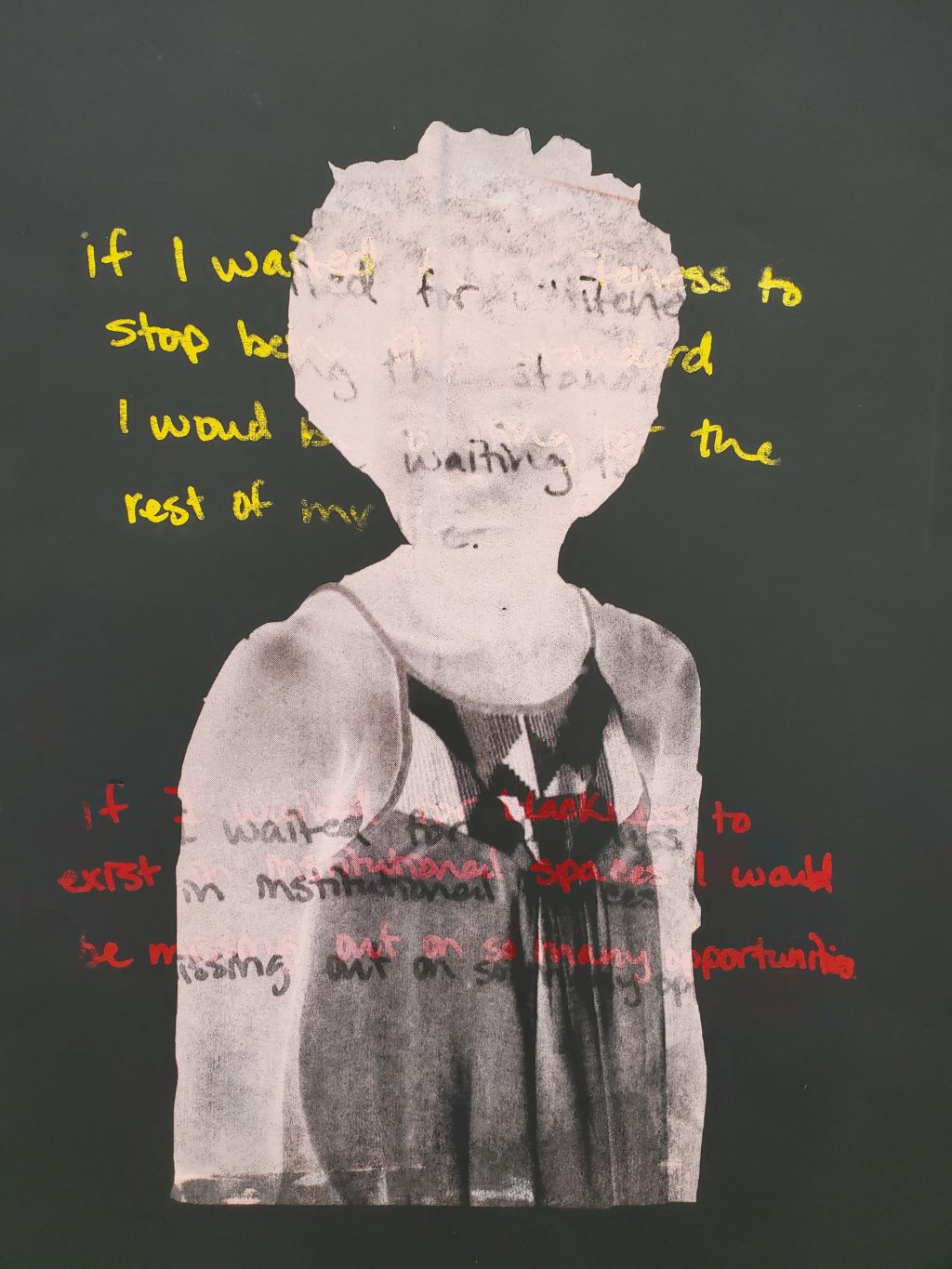
LG – I was thinking about how if I am waiting for things to get done by other people or institutions, I would put a hold on my own goals. I am the only Black woman in this MFA program, and some of the things that happen are in conflict with my own beliefs. But if I let that get in the way from what I want to do or where I want to go, then I would be waiting forever. If I wait for a system to be perfect then I will miss out on a lot of opportunities.
JW – That makes a lot of sense.
LG – How are you reflecting on your whiteness currently since last summer? Even in our own school, we have had our own protest letters put together by the MFA grads that were directed to the administration’s lack of response to police brutality. So many folks were posting the black square or had a little Black Lives Matter section on their feed. There is all this Diversity, Equity, Inclusion talk. Has the urgency faded for you at all or what are you thinking now?
JW – I think that is a really good question because in the summer and early fall everyone was engaging at a new level. I don’t see it on social media as much now and some folks seem to have forgotten and moved on in certain ways. That is part of why I wanted to show this flag again, because I want to keep working and thinking about this. Part of that is knowing that even though us MFAs did that protest* and there were protests in the summer, not that much has really changed in the systemic structures of white supremacy. If things aren’t changing, we need to keep talking about all of this and making some real change in all these institutions. In everything that I do now I need to make sure I have the perspective that my whiteness is a part of it. It is a part of me and my artwork and that will not be going away. Part of what I am learning and I am learning a lot, is that it is exhausting to always be thinking about this and work for something better, but I need to make that choice. I am not perfect, but I want to keep bringing it up. That is how I feel right now thinking about my whiteness within art institutions.
LG – Just keep bringing it up.
JW – And I think that can happen at a lot of different levels. Even now just bringing more awareness to critiques, if someone is having their work talked about in a way that isn’t relevant to them or people blatantly not understanding it because it’s not white-centered, I need to speak up and point to that dynamic. It’s not always going to happen within art, but it’s something I am still trying to make work about and have conversation about.
JW – The text in your flag piece, you talk about this state of being trapped in a place where you cannot achieve success if you wait for institutions to change. Do you see this work as a way to defy this entrapment of the slow pace of institutional change? Or just to talk about it?
LG – It is a venting outlet and awareness statement. I am naming my reality. The highlight I see in institutions is them bragging about the few students of color on campus they have or how progressive they are when they really aren’t. So this is me trying to share my experiences and the details no one asks about or focuses on. You get asked about your art or the program, but not the emotional toll or micro aggressions or macro aggressions you experience on a regular basis, and all these in between areas that are hard to address. To me, I was just doing that and responding to the things that go overlooked.
It’s also a validating of my own experience. I get gaslit a lot so there is a feeling like you can’t complain in this space when you have this opportunity. That is the attitude of institutions anyway, that you can’t critique it from within. I highly disagree with that. Just because I am in this amazing opportunity with these amazing people, it doesn’t mean it’s perfect or that there are not areas that it needs to be worked on.
LG – In that regard Juliette, do you feel like your practice is a resistance? Being a white woman artist, you are choosing to question and challenge other white people. Do you feel like there are parallels there to your way of making in general? You do challenge a more traditional way of making by actively collaborating with others.
JW – It does sometimes feel like a resistance. I am trying to find the right words to describe it. I think what I am trying to do in my art practice is show the importance of relationships and collaborating. How those feel so much more important to me than just the idea of producing products for the art market. So that is an anti-capitalist stance and there is some resistance in that. But yes, I am interested in a resistance to a business as usual mentality that a lot of art institutions have. Even if the resistance is just asking questions, I think that is very important. Why are we continuing to operate this way? Perhaps it’s not as forceful as it needs to be.
LG – But those things can grow over time.
JW – Could you talk about your processes with printmaking, collaging, and layering and what those processes mean for your work?
LG – I use layering as a way to reveal and conceal the things I am trying to address in my work. I highlight vulnerability in my work. A lot of things are uncomfortable to digest for me or potentially for a viewer. So I am looking to preserve some energy for myself. I will conceal things and other moments I will reveal them. The images alone can have concealed elements, but language helps guide the viewer into what I am talking about. With this flag, I combined those together. Other times I keep them separate.
JW – Thank you for being vulnerable with me Leah and for sharing all of this about your work.
LG- Thank you.
* University of Arkansas MFA students sent protest letters via email to faculty and administrators in June 2020; we followed up by presenting these amended University of Arkansas statements to administrators: here and here.

